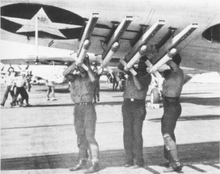| 3.5-inch forward firing aircraft rocket, 3.5" FFAR | |
|---|---|
 3.5-inch FFARs being mounted underwing on a Grumman TBF Avenger | |
| Type | Anti-submarine rocket |
| Place of origin | US |
| Service history | |
| Used by | United States Navy |
| Production history | |
| Produced | 1943–1944 |
| Specifications (3.5-inch FFAR) | |
| Mass | 54 pounds (24 kg) |
| Length | 4 feet 7 inches (1.40 m) total = 45 inches (1,100 mm) motor length + 10 inches (250 mm) steel warhead length |
| Diameter | Motor 3.25 inches (83 mm), solid steel warhead 3.5 inches (89 mm) |
| Warhead | None |
| Engine | Caltech solid-fuel rocket 2,300 lbf (10.4 kN) |
Operational range | 1,500 yards (1,400 m) nominal firing range |
| Maximum speed | 1,045 miles per hour (1,682 km/h) = 1,180 feet per second (360 m/s) rocket delta V plus + 240 miles per hour (390 km/h) approx. aircraft speed |
Guidance system | None |
The 3.5-inch Forward Firing Aircraft Rocket, or 3.5-Inch FFAR, was an American rocket developed during World War II to allow aircraft to attack enemy submarines at range. The rocket proved an operational success, and spawned several improved versions for use against surface and land targets.